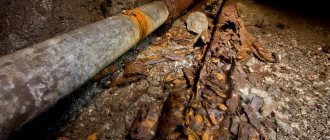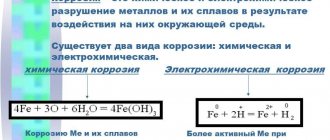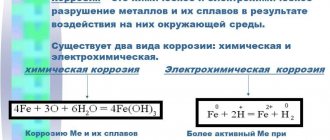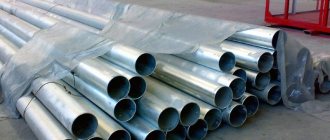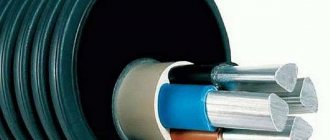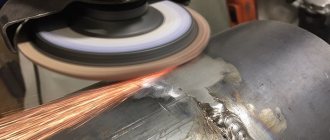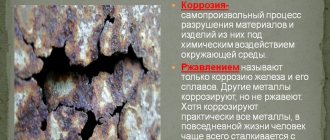Thousands of years of development of civilization would have been impossible without the metal from which both arrowheads and spears of the prehistoric period, and the most complex machines of our time were made. Entire eras bear “metal” names: bronze, copper, iron. Metallurgical plants work around the clock to provide the industry with the necessary quantity of metal blanks. Machine-building enterprises make a huge range of products from them, from pipes, rails and sheets, to needles and pins.
Metal corrosion , especially its main type - electrochemical, has always created difficulties in the operation of any metal products, destroying them untimely. The simplest tools (knife, ax, plow) quickly became unusable in a humid environment. It took numerous and lengthy studies of chemical destruction processes before technical solutions were found that stopped the corrosion of metals.
Definition of corrosion
Metal materials under chemical or electrochemical influence of the environment are subject to destruction, which is called corrosion.
Corrosion of metals is caused by redox reactions, as a result of which metals become oxidized and lose their properties, which renders metal materials unusable.
There are 3 signs that characterize corrosion:
- Corrosion is, from a chemical point of view, a redox process.
- Corrosion is a spontaneous process that occurs due to the instability of the thermodynamic system metal - environmental components.
- Corrosion is a process that develops mainly on the surface of the metal. However, it is possible that corrosion can penetrate deep into the metal.
Main objects of corrosion
Inhomogeneous metal areas are randomly located on the surface of the product and depend on the technology and quality of their manufacture, so corrosion damage is often local in nature. In addition, the locality of corrosion depends on heterogeneity:
- protective oxide films;
- electrolyte;
- influence of external factors (heating, irradiation);
- internal stresses causing uneven deformation.
Welded and riveted joints are prominent representatives of the contact of foreign metals subject to active electrochemical corrosion. Welding and riveting are the most common technologies in the construction of permanent joints in all leading industries and large pipeline systems:
- mechanical engineering;
- shipbuilding;
- oil pipelines;
- gas pipelines;
- water pipes.
The most significant damage to welds and rivet joints occurs in sea water, the presence of salt in which significantly accelerates the corrosion process.
A catastrophic situation arose in 1967 with the ore carrier Anatina , when sea water from high storm waves entered the ship’s holds. Copper structures in the interior of the holds and the steel hull contributed to the creation of a corrosive element in the seawater electrolyte. Transient electrochemical corrosion caused softening of the ship's hull and the creation of an emergency situation, leading to the evacuation of the crew.
The positive effect of electrochemical corrosion is very rare. For example, when installing new pipes in hot heating systems of residential buildings. The threaded connections of the couplings begin to flow during the initial start-up until corrosion products consisting of hydrated iron fill the micropores in the threads.
Regardless of the type of corrosion, chemical or electrochemical, its consequences are the same - the destruction of products of enormous value . Moreover, in addition to direct losses from materials that have become unusable, there are indirect losses associated with product leaks, downtime when replacing unusable materials and parts, and violations of technological process regulations.
Types of metal corrosion
The most common types of metal corrosion :
- Uniform – covers the entire surface evenly
- Uneven
- Electoral
- Local stains – individual areas of the surface are corroded
- Ulcerative (or pitting)
- Spot
- Intercrystalline - spreads along the boundaries of a metal crystal
- Cracking
- Subsurface
Main types of metal corrosion
From the point of view of the mechanism of the corrosion process, two main types of corrosion can be distinguished: chemical and electrochemical.
Main varieties
During corrosion in electrolytes, chemical energy is converted into electrical energy. In this regard, it is called electrochemical. It is customary to distinguish the following types of electrochemical corrosion.
Intercrystalline
Intergranular corrosion refers to a dangerous phenomenon in which the grain boundaries of nickel, aluminum and other metals are destroyed in a selective manner. As a result, the strength and plastic properties of the material are lost. The main danger of this type of corrosion is that it is not always visually noticeable.
Pitting
Pitting electrochemical corrosion is a point lesion of individual areas of the surface of copper and other metals. Depending on the nature of the lesion, closed, open, and superficial pitting are distinguished. The size of the affected areas can vary from 0.1 mm to 1.5 mm.
Slotted
Crevice electrochemical corrosion is commonly called the intensified process of destruction of metal structures in the locations of cracks, gaps and cracks. Crevice corrosion can occur in air, gas mixtures, and sea water. This type of destruction is typical for gas pipelines, the bottoms of sea vessels and many other objects.
Corrosion occurs in conditions of a small amount of oxidizer due to the difficult approach to the crack walls. This leads to the accumulation of corrosive products inside the gaps. The electrolyte contained in the internal space of the gap can change under the influence of hydrolysis of corrosion products.
In order to protect metals from crevice corrosion, it is common to use several methods:
- sealing gaps and cracks;
- electrochemical protection;
- inhibition process.
As preventive methods, you should use only those materials that are least susceptible to rust, and also initially correctly and rationally design gas pipelines and other important objects.
Competent prevention in many cases is a simpler process than subsequent cleaning of metal structures from ingrained rust.
Electrochemical corrosion of metals
Electrochemical corrosion of metals is the process of destruction of metals in the environment of various electrolytes, which is accompanied by the appearance of an electric current inside the system.
With this type of corrosion, an atom is removed from the crystal lattice as a result of two coupled processes :
- Anodic - metal in the form of ions goes into solution.
- Cathode – the electrons formed during the anodic process are bound by a depolarizer (the substance is an oxidizing agent).
The process of removing electrons from the cathode sites is called depolarization , and substances that promote removal are called depolarizers.
The most common corrosion of metals is with hydrogen and oxygen depolarization .
Hydrogen depolarization
Hydrogen depolarization is carried out at the cathode during electrochemical corrosion in an acidic environment :
2H++2e— = H2 discharge of hydrogen ions
2H3O++2e— = H2 + 2H2O
Oxygen depolarization
Oxygen depolarization is carried out at the cathode during electrochemical corrosion in a neutral environment :
O2 + 4H++4e— = H2O reduction of dissolved oxygen
O2 + 2H2O + 4e— = 4OH—
All metals, in their relation to electrochemical corrosion, can be divided into 4 groups, which are determined by the values of their standard electrode potentials:
- Active metals (high thermodynamic instability) are all metals in the range of alkali metals - cadmium (E0 = -0.4 V). Their corrosion is possible even in neutral aqueous environments in which there is no oxygen or other oxidizing agents.
- Metals of medium activity (thermodynamic instability) are located between cadmium and hydrogen (E0 = 0.0 V). In neutral environments, in the absence of oxygen, they do not corrode, but are subject to corrosion in acidic environments.
- Low-active metals (intermediate thermodynamic stability) - are located between hydrogen and rhodium (E0 = +0.8 V). They are resistant to corrosion in neutral and acidic environments in which there is no oxygen or other oxidizing agents.
- Noble metals (high thermodynamic stability) - gold, platinum, iridium, palladium. They can be subject to corrosion only in acidic environments in the presence of strong oxidizing agents.
Types of electrochemical corrosion
Electrochemical corrosion can occur in various environments. Depending on the nature of the environment, the following types of electrochemical corrosion are distinguished:
- Corrosion in electrolyte solutions - in solutions of acids, bases, salts, in natural water.
- Atmospheric corrosion - in atmospheric conditions and in any humid gas environment. This is the most common type of corrosion.
For example, when iron interacts with environmental components, some of its sections serve as the anode, where iron oxidation occurs, and others serve as the cathode, where oxygen reduction occurs:
A: Fe – 2e— = Fe2+
K: O2 + 4H+ + 4e— = 2H2O
The cathode is the surface where the oxygen flow is greater.
- Soil corrosion - depending on the composition of the soil, as well as its aeration, corrosion can occur more or less intensely. Acidic soils are the most aggressive, while sandy soils are the least.
- Aeration corrosion occurs when there is uneven access of air to different parts of the material.
- Marine corrosion - occurs in sea water due to the presence of dissolved salts, gases and organic substances in it .
- Biocorrosion - occurs as a result of the activity of bacteria and other organisms that produce gases such as CO2, H2S, etc., which contribute to metal corrosion.
- Electrocorrosion - occurs under the influence of stray currents in underground structures, as a result of the work of electric railways, tram lines and other units.
Closed-loop galvanic cell
Rust coating of steel parts in a humid environment is the most common example of galvanic corrosion. There is no absolutely pure water in nature; it always contains impurities that conduct electricity. This means that ordinary, non-distilled water is always an electrolyte. In real-life iron there are inhomogeneities due to the crystal structure and all kinds of impurities. Because of this, there are zones on the metal surface with different electrochemical potentials. The ingress of moisture onto the surface of ordinary steel causes the formation of a large number of microscopic galvanic elements closed on themselves. Currents flow through them, causing electrochemical corrosion. Their values are negligible, but serious destruction occurs over a long period of time.
More severe electrochemical corrosion occurs when two objects made of different materials are placed in an electrolyte. Then the potential difference between them reaches several volts, and the current value is also very large. In essence, a full-fledged galvanic cell is formed. This type of corrosion occurs in inexpensive plumbing fixtures of unknown origin.
Methods of protection against metal corrosion
The main method of protecting metal from corrosion is the creation of protective coatings - metallic, non-metallic or chemical.
Metal coatings
A metal coating is applied to the metal that needs to be protected from corrosion with a layer of another metal that is resistant to corrosion under the same conditions. If the metal coating is made of a metal with a more negative potential (more active) than the one being protected, then it is called an anodic coating . If the metal coating is made of a metal with a more positive potential (less active) than the one being protected, then it is called a cathodic coating .
For example, when applying a layer of zinc to iron, if the integrity of the coating is compromised, the zinc acts as an anode and will be destroyed, while the iron is protected until all the zinc is used up. The zinc coating in this case is anodic .
The cathode coating to protect the iron may, for example, be copper or nickel. If the integrity of such a coating is violated, the protected metal is destroyed.
Non-metallic coatings
Such coatings can be inorganic (cement mortar, glassy mass) and organic (high molecular weight compounds, varnishes, paints, bitumen).
Chemical coatings
In this case, the protected metal is subjected to chemical treatment in order to form a corrosion-resistant film of its compound on the surface. These include:
oxidation – production of stable oxide films (Al2O3, ZnO, etc.);
phosphating – obtaining a protective film of phosphates (Fe3(PO4)2, Mn3(PO4)2);
nitriding – the surface of the metal (steel) is saturated with nitrogen;
steel bluing - the metal surface interacts with organic substances;
carburization – obtaining on the surface of a metal its connection with carbon.
Changes in the composition of technical metal and corrosive environment
Changing the composition of the technical metal also helps to increase the metal's resistance to corrosion. In this case, compounds are introduced into the metal that increase its corrosion resistance.
Changing the composition of the corrosive environment (introducing corrosion inhibitors or removing impurities from the environment) is also a means of protecting the metal from corrosion.
Electrochemical protection
Electrochemical protection is based on connecting the protected structure to the cathode of an external direct current source, as a result of which it becomes the cathode. The anode is scrap metal, which, when destroyed, protects the structure from corrosion.
Protective protection - one of the types of electrochemical protection - is as follows.
Plates of a more active metal, called protector . The protector - a metal with a more negative potential - is the anode, and the protected structure is the cathode. The connection of the protector and the protected structure with a current conductor leads to the destruction of the protector.
Examples of problems with solutions for determining the protective properties of oxide films, determining the corrosion resistance of metals, as well as equations for reactions occurring during electrochemical corrosion of metals are given in the section Problems for the section Corrosion of metals
Categories Corrosion of metals, GENERAL CHEMISTRY
Is it possible to eliminate traces of electrochemical corrosion?
Unfortunately, there is no 100% method of corrosion protection, at least not an economically feasible one. Any product will sooner or later undergo aging, and it will be difficult to get rid of it. If the product begins to rust, you should first determine the cause.
Unfortunately, there is no 100% method of corrosion protection, at least not an economically feasible one. Any product will sooner or later undergo aging, and it will be difficult to get rid of it. If the product begins to rust, you should first determine the cause.
Atmospheric corrosion is most often encountered in everyday life, and the way to eliminate it is by applying non-metallic components, or, more simply, by painting. However, this also has its own nuances, since if traces of corrosion are not eliminated, it will continue to spread under the coating, reducing all efforts to zero.
First you need to eliminate the source of infection. Most of these are superficial lesions that are removed mechanically, that is, by stripping. Difficulties arise with areas of deep penetration, when it is not possible to remove such a layer to eliminate the defect. Also, special attention should be paid to removing the oxide film from the surface. It is the same electrolyte. A simple way is degreasing. Any means with an octane number are used: gasoline, solvent, and so on. This process should not be neglected, since if a film remains on the painted surface, the destruction will continue even under a layer of enamel or polymer.
Better yet, contact a management design engineer. He will tell you the root of the problem and help with its solution.
